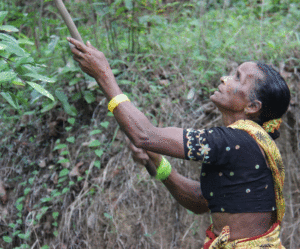
An estimated 1.6 billion people worldwide live in and around forests, and depend on them for their livelihoods. However, forest degradation and deforestation are accelerating, and endangering local livelihoods.
The careful management and conservation of biodiversity are fundamental for sustaining ecosystems and livelihoods but are increasingly difficult to achieve in contexts of persistent poverty, a growing international demand for timber and non-timber forest products (NTFP), and climate change.
Moreover, at the local level, decision-making power on management of forests and forest products, and the sharing of related costs and benefits are often inequitably distributed across groups, marginalizing people based on gender, caste, ethnicity, socioeconomic status, and other factors of social differentiation.
A new publication, Guidelines for Equitable and Sustainable Non-timber Forest Product Management, offers field-tested strategies and good practices on how to pursue the multiple goals of gender equality and social inclusion, environmental integrity, and livelihoods improvement through the sustainable use and management of non-timber forest products.
To address some of these challenges, many countries have adopted community-based or joint forest management approaches. It is increasingly recognized that gender equity and social inclusion are key components of effective and efficient forest management approaches, as well as a goal. Yet, they are also a complex challenge with deep-seated causes and effects, including poor governance, corruption, and lack of tangible and equally distributed benefits, all of which hinder sound forest management.
In their new publication, Guidelines for Equitable and Sustainable Non-timber Forest Product Management, Bioversity International scientists Riina Jalonen, Hugo Lamers, and Marlène Elias draw from their experience in two Indian districts – Mandla, in the state of Madhya Pradesh, and Uttara Kannada, in the state of Karnataka – to provide guidance on how to pursue the triple goals of gender equality and social inclusion, environmental integrity, and improved livelihoods through the sustainable use and management of NTFPs.
NTFPs are of foremost importance for rural communities living in or near forests. For example, the flower of the mahua tree (Madhuca longifolia), which is used to make a local alcohol or as an alternative to coffee in the Mandla district, or the rind of the kokum fruit (Garcinia gummi-guta) found in Uttara Kannada district, which is valued for its weight loss properties in the international pharmaceutical industry, bring important income to local households. Other NTFPs, like mangoes in the Uttara Kannada district, also play an integral role for home consumption and are important for the local food culture.
Read more: Bioversity International’s research on the sustainable use of forest diversity

The set of six good practice guidelines address some of these issues through a focus on:
- Promoting collective sales of NTFPs
- Fostering gender equity and inclusion in joint forest management
- Achieving income generation and forest regeneration through the collection of ripe fruit
- Avoiding tree damage as a result of the collection of NTFPs
- Effective monitoring of forests to improve management
- Restoring degraded forest landscapes through planting of valuable trees.
For example, the guideline on gender equity and social inclusion in joint forest management (JFM) details how women’s participation can improve the efficiency of JFM and lead to more gender-equal outcomes. Yet, women face time, mobility, and information constraints, as well as norms that discriminate against them in public decision-making spaces. These have to be addressed to allow them to participate meaningfully in JFM, and to make their voices heard in decision-making.
Additional constraints can be found at the intersection of gender, age, and ethnicity or caste. In the study districts, participating in JFM meetings is considered a “man’s role”, and women often feel out of place there. They are not encouraged to express their opinions, despite the fact that they have a rich knowledge of the forest. This is especially the case for women from marginalized castes or tribes, who are most dependent on, and knowledgeable about, the forest, but also most discriminated against.
The guidelines propose strategies to promote women’s participation in JFM, such as scheduling meetings at times and in places convenient for women, creating women-only spaces where women can speak their minds freely to then have their opinions brought to the JFM table, improving the flows of information towards local women.
The practical strategies proposed in the guidelines can be used by facilitators working with communities to improve their livelihoods through the sustainable and equitable use and management of NTFPs. Practitioners can use the guidelines to design and conduct community meetings that can help participants identify practices that are fitting for their context. Questions are presented in the guidelines as the basis for group discussions, which can foster participants to find and implement collective solutions to improve the state of their forests and their livelihoods.
Read also: Guidelines for Equitable and Sustainable Non-timber Forest Product Management
By Giulia Micheletti and Marlène Elias, originally published by Bioversity International.
For more information, contact r.jalonen@cgiar.org.
The Guidelines for Equitable and Sustainable Non-Timber Forest Product Management were developed as part of the project ‘Innovations in Ecosystem Management and Conservation (IEMaC)’, supported by USAID India Mission, and are part of the CGIAR Research Program on Forests, Trees and Agroforestry, which is supported by the CGIAR Trust Fund.











